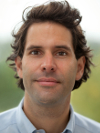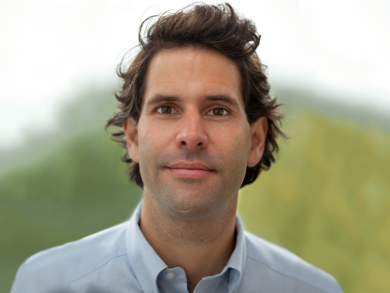During their editorial work, Editors of Angewandte Chemie, including Dr. Stephen Horner, come across very creative web pages of research groups. This made us curious to find out who is behind these great ideas.
Here, Dr. Vera Koester from ChemViews Magazine talks with Professor Peter Gilch, Heinrich Heine University (HHU) Düsseldorf, Germany, about his research group, their eye-catching website, and his research.
Please describe your web page. What makes it special?
The general layout of the web page is defined by the corporate design of my university – the HHU Düsseldorf. What catches the eye is our group photo which is an animated gif. It shows the group queuing at the coffee machine which is – as I guess in many groups – our social center of gravity. I am last in the queue but – thanks to a toy robot with a laser – I can erase my co-workers and be first in line. Unfortunately, I have misprogrammed the robot so it also erases me.
Photo: Gilch Group, University of Düsseldorf, Germany.
What gave you the idea for this web page?
When you take pictures for your group photo you usually take many, so that you can select the best ones afterward. When you flip these pictures back and forth on the camera display, you get the impression of a (low quality) movie. So a couple of years ago, we decided to put these pictures together and show these “movies” on the web. In them – there is a small collection on our web page – you see us gathering for the photo, jumping from buildings, getting eaten by pac man or erased by a toy robot. One might interpret that as a reflection on the transient character of a research group: Bachelor, Master, and Ph.D. students work with us only for a limited time. But this is probably too much interpretation …
Who created the pictures?
The pictures were taken by Kristoffer Thom, who is now a Master student in my group. The “photoshopping” was done by my Ph.D. students Anna Reiffers and Martin Huber.
Which reactions have there been to the photos?
Until now not that many, I hope this will change due to this coverage. A colleague of mine, Dr. Sanders Smits, is quite enthusiastic about these photos. So, as the member of a very exclusive fan club, we keep him posted about new pictures.
The daughter of a friend of mine who is very much into video filming said “Oh je” (“Oh dear”), when she saw the picture, presumably commenting on its technical quality.
What is your research focused on?
We are physical chemists and physicists using pulsed lasers for time-resolved spectroscopy, particularly femtosecond spectroscopy, and for Raman microscopy. With our femtosecond methods, we study UV-induced DNA photo-lesion, fast spin-forbidden processes, and the mechanisms of complex photoreactions.
Among these studies, presumably those on DNA photo-lesions have the highest public impact. UV radiation is part of the solar spectrum and exposure to it will damage the DNA, for instance, in your skin cells. The result is sunburn and, if worse comes to worst, skin cancer. With our experiments, we aim at a molecular understanding of the formation of these photo-lesions. We have recently shifted our interest from the intrinsic photo-reactivity of DNA to photo-reactions between DNA and other substances like pharmaceuticals.
In Raman microscopy, a focused laser beam scans over the sample of interest. For every spot, one records a Raman spectrum. This spectrum is very informative about the chemical constituency of the sample, so one can derive “chemical maps” of microscopic objects. Acquisition speed is crucial here. Assuming it takes one second to acquire the spectrum of one spot, it takes around three hours for an image with 100 x 100 (10.000) pixels. 10.000 pixels are not very impressive in the days of ten-megapixel cameras. So many groups try to speed up the acquisition of images by relying on non-linear interactions, which require femtosecond lasers. Here, we pioneered the application of one particular type of interaction, namely stimulated Raman scattering.
Is there anything else you would like readers of ChemViews Magazine to know about your website, your research, or your group?
The robot has not erased the buttons on the left which guide you to stuff we are after scientifically.
That is good to know. Thank you very much for the interview.
- Website of the Gilch research group: www.gilch.hhu.de
 Peter Gilch, born in Bonn, Germany, in 1970, studied chemistry at the University of Konstanz, Germany. He received his Diploma from there in 1995 and his Ph.D. from the Technical University of Munich, Germany, in 1999. From 1999 to 2005, Gilch was a Scientific Assistant at the University of Munich. He completed his habilitation in experimental physics in 2005. Since 2009, Peter Gilch is Professor at the Heinrich Heine University.
Peter Gilch, born in Bonn, Germany, in 1970, studied chemistry at the University of Konstanz, Germany. He received his Diploma from there in 1995 and his Ph.D. from the Technical University of Munich, Germany, in 1999. From 1999 to 2005, Gilch was a Scientific Assistant at the University of Munich. He completed his habilitation in experimental physics in 2005. Since 2009, Peter Gilch is Professor at the Heinrich Heine University.
Selected Awards
- Albert Weller Award from the Gesellschaft Deutscher Chemiker (GDCh, German Chemical Society), 1999
Selected Publications by Peter Gilch
- Femtosecond Spectroscopy of Calcium Dipicolinate—A Major Component of Bacterial Spores,
R. Mundt, C. Torres Ziegenbein, S. Fröbel, O. Weingart, P. Gilch,
J. Phys. Chem. B 2016, 120, 9376–9386.
DOI: 10.1021/acs.jpcb.6b06230 - Broadband stimulated Raman microscopy with 0.1 ms pixel acquisition time,
L. Czerwinski, J. Nixdorf, G. Di Florio, P. Gilch,
Opt. Lett. 2016, 41, 3021.
DOI: 10.1364/ol.41.003021 - Femtochemistry of selected di-substituted benzenes,
S. Fröbel, P. Gilch,
J. Photochem. Photobiol., A 2016, 318, 150–159.
DOI: 10.1016/j.jphotochem.2015.05.036 - Early Events of DNA Photodamage,
W. J. Schreier, P. Gilch, W. Zinth,
Annu. Rev. Phys. Chem. 2015, 66, 497–519.
DOI: 10.1146/annurev-physchem-040214-121821 - Chimeric Behavior of Excited Thioxanthone in Protic Solvents: I. Experiments,
T. Villnow, G. Ryseck, V. Rai-Constapel, C. M. Marian, P. Gilch,
J. Phys.Chem. A 2014, 118, 11696–11707.
DOI: 10.1021/jp5099393 - Magnetic Field and Temperature Dependencies Shed Light on the Recombination Kinetics of a Transition Metal Donor/Acceptor System,
T. von Feilitzsch, P. Härter, O. Schiemann, M. E. Michel-Beyerle, U. E. Steiner, P. Gilch,
J. Am. Chem. Soc. 2005, 127, 15228–15235.
DOI: 10.1021/ja0547174
|
Do you also have an interesting, creative, or different website for your research group, or do you know someone else who does? |





